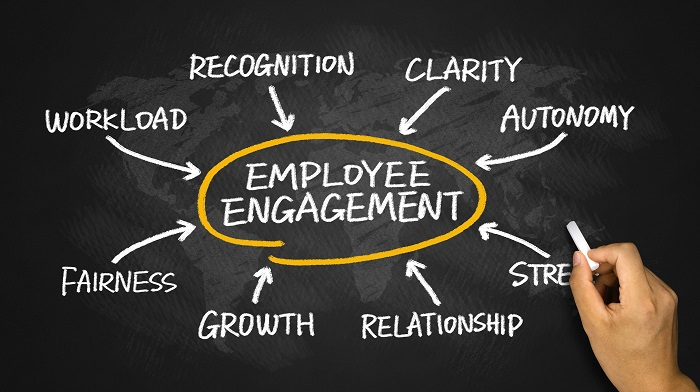
 Data Structure
Data Structure Networking
Networking RDBMS
RDBMS Operating System
Operating System Java
Java MS Excel
MS Excel iOS
iOS HTML
HTML CSS
CSS Android
Android Python
Python C Programming
C Programming C++
C++ C#
C# MongoDB
MongoDB MySQL
MySQL Javascript
Javascript PHP
PHP
- Selected Reading
- UPSC IAS Exams Notes
- Developer's Best Practices
- Questions and Answers
- Effective Resume Writing
- HR Interview Questions
- Computer Glossary
- Who is Who
Trending Ways to Engage with Your Employees in 2023
The world has opened up, as have the number of issues affecting an individual and their lifestyle. Employee satisfaction has suffered greatly in recent years as we have transitioned to digital infrastructure and a more technologically advanced setup. With the pandemic, lockdown, war in Ukraine, and growth rate of inflation, to name a few, employees have become more detached from their work and the company.
The work-from-home model has myriad benefits, but at the same time, it has also created the problem of job switching. Companies now struggle with the retention of employees. There is always another company willing to pay more. Hence, in this article, we will be understanding what could be some of the employee engagement activities done in 2023 that can ensure that the employees feel more connected to the company and their work. These will be the simple changes that an organization can make by itself to ensure a happy and satisfied workforce.

The Concept of Employee Engagement
Employee engagement, in simple terms, means the emotional connection of the employee with the organization. With the hybrid and work-from-home models, it is very difficult for companies to ensure that the employees feel connected with the company. Most of the employees have not been to their office in years. Employee engagement activities will ensure that employees feel a sense of belonging, and they will want to give their best for the organization and its success. It is something that cannot be earned through the compensation factor but by satisfying the needs of individuals.
Trends in Employee Engagement in 2023

Provide your employees with flexible working hours ? The trend today is to provide employees with flexibility. Companies have to understand they are not dealing with a front-line, manual, and uneducated workforce. Employees of today are educated individuals who provide mental stimulation to the company. Employees prefer coaching as a style of management. where they can seek help in a complicated situation but handle most of the other problems on their own. This helps them develop their skillset and knowledge as well.
Provide your employees with a hybrid mode of working ? During the pandemic, businesses have successfully operated in a work-from-home structure for years. Both the employees and the workforce are aware of the benefits of the work-from-home structure. Now forcing the employees to get back to the traditional structure entirely makes no sense. Employees now have a taste of freedom, and this is something they would appreciate more than the compensation structure. Companies can also create a positive atmosphere where the employees are actually excited to come to work. A hybrid structure seems to be the balance between two parallel worlds and ensures happier and more engaged employees.
Develop an inclusive workforce ? A positive work atmosphere is a must for the employees to give their best and for the companies to have the utmost resource utilization. A company can create an inclusive workforce by ensuring that everyone in the team is heard, we have diversity, equity, and inclusion policies in place, employees are forced to follow rigid dress codes or timing structures, employees are not overburdened with work, and others. These small steps will ensure the organization runs efficiently and has an inclusive workforce that is ready to give their all to the company.
Appreciate the efforts of your employees ? Irrespective of the career level of the employee, the total working experience, or the designation of employees, getting recognized for their work, fast thinking, and flexible approach go a long way. An employee may give their all, but they will not wait until the end of the year to be recognized for their efforts. They need to be appreciated for all their efforts. Companies can?
Quarterly rewards and recognition programs.
Companies can create social media posts to appreciate the efforts of their employees.
Companies can conduct monthly birthday celebrations.
Companies can occasionally give small tokens of appreciation to their employees, such as food coupons.
Provide your employees with ample opportunities for career growth ? No employee would want to stick with a job for years. Employees are on the run to be their best, and hence, companies can take this opportunity and gift themselves as well with an employee that is constantly upskilling with the market trends. Companies can have strong learning and development teams that can help the employees increase their knowledge in a particular field as well as provide opportunities to learn new things. For example, UI developers and UX designers can learn accessibility as their secondary skill.
Mental, Emotional, and Physical well-being ? employees need to be mentally, physically, and emotionally healthy to provide the deliverable. If anyone of these aspects is missing, the company can expect a passive attitude towards work, a lack of accuracy, and a slow pace among the employees. Companies can help employees with wellness sessions in which they can understand how they can work toward improving their mental, physical, and emotional well-being. Weekly or 15-day sessions can be really impactful for the employee's well-being.
Have standard KRA and KPI indicators ? We are far from the era where the employee who shouts a lot or sends 50 emails a day is the one who is working the most and the best. Since employers will not be able to see their employees working every day, it is important they set up relevant, objective, and timely key results areas and key performance indicators. This will help employers provide a fair appraisal amount, and employees will also feel satisfied as everything is measurable and not based on the whims and fancies of people.
Agile and flatter organization structure ? Companies today should operate on a flatter and more agile organization structure instead of bureaucratic hierarchies. We are moving to a westernized world where the competency of an individual is appreciated and not their work experience or age. Some of the initiatives could include calling every employee in the organization by their first name instead of adding sir or ma'am afterward. Agile and flatter structures would also ensure that decisions are made quickly and employees have ample opportunities to deal with bigger and more relevant problems.
Benefits of Employee Engagement Activities

Employee engagement activities will give the company an edge over its competitors because now the company can benefit from?
Reduced Employee Turnover ? Employee retention, the major problem faced by companies all over the globe, will be solved.
Reduced Absenteeism ? Employees will not be on sick leave as often, and they will not find ways to slack off from work.
A more productive workforce ? Employees who are happy and engaged will give their all to every task they undertake. The productivity of the workforce will be increased at all costs.
Positive Aura in the office ? Engaged employees will care about their work and the company. Since they are satisfied with the services provided by their employees, they will spread positive word of mouth and will take every challenge as an opportunity to grow. Hence, a positive aura is the byproduct of an engaged workforce.

Loyal and dedicated workforce ? Employees are going to stick by the company through thick and thin.
We now have a clear understanding of the different employee engagement activities that companies can conduct and what will be the benefits of the same. Our economy is fighting some major crises, so companies have to ensure that their employees stick by them. It is time that companies target their emotional needs.

